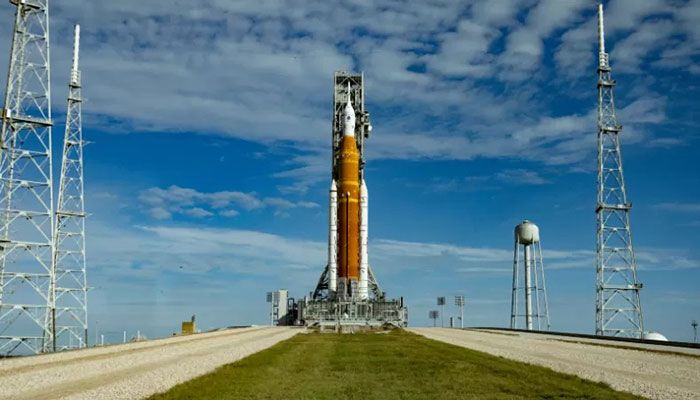
Countdown Halted for NASA’s Mega Rocket Launch
Desk Report
Published: 16 Nov 2022, 10:55 am

The Artemis I unmanned lunar rocket sits on launch pad 39B at NASA's Kennedy Space Center in Cape Canaveral, Florida, on November 13, 2022 || AFP Photo
NASA was readying to launch its new mega Moon rocket early Wednesday from Florida -- but technical issues threatened to play spoilsport a third time, reports AFP.
Engineers were forced to pause flowing liquid hydrogen into the core stage because of a valve leak in the mobile launcher ground structure, as a team was sent out to address the problem.
If the issue is resolved, weather remains 90 per cent favourable for lift-off during a two-hour window that begins at 1:04 am local time (0604 GMT).
The Artemis 1 mission, a test flight without astronauts, represents the first step in the US space agency's plan to build a lasting presence on the Moon and take lessons from there to prepare for a future voyage to Mars in the 2030s.
Named after the sister of Apollo in Greek mythology, the new space program comes 50 years after humans last set foot on lunar soil.
It will be the first launch of the 32-story tall Space Launch System rocket, the most powerful ever built.
For now, the countdown remains paused at the storied Kennedy Space Centre, where the orange and white behemoth awaits its maiden flight.
The take-off is scheduled less than a week after the passage of Hurricane Nicole, which the rocket endured outside on its launch pad.
The hurricane damaged a thin strip of caulk-like material which encircles the Orion crew capsule atop the rocket, making it more aerodynamic. However, NASA said Monday that this posed a minimal risk.
Two backup dates are possible, if needed, on November 19 and 25.
'Extremely excited'
About 100,000 people are expected on the coast to watch the launch, with the rocket promising to light up the night sky.
Andrew Trombley, a space enthusiast from St. Louis, Missouri, is anxiously hoping for a successful lift-off after several futile trips for the launch.
"I've been down here a couple of times already to watch this thing go up and have it cancelled so, this is like, whatever, the third trip down here for this, so I'm excited to see it go," said the network engineer.
"I was too little for the Apollo missions, so ... I wanted to be here in person."
The launch has attracted hordes of tourists, as well as locals.
Kerry Warner, 59, a grandmother and semi-retired educator who lives in Florida, is fired up for lift-off, which she said was "part of America and what America is all about."
"Third time's the charm, we're hoping for it."
Far side of Moon
At the end of September, the rocket had to be wheeled back to its assembly building to be sheltered from another hurricane, Ian.
Before these weather setbacks, two launch attempts were cancelled for technical reasons.
The first failure was related to a faulty sensor, and the second to a fuel leak when filling the rocket's tanks. It runs on ultra-cold, ultra-volatile liquid oxygen and hydrogen.
NASA has since replaced a seal and modified its procedures to avoid thermal shock as much as possible.
The Orion capsule will be lifted by two boosters and four powerful engines under the core stage, which will detach after only a few minutes.
After a final push from the upper stage, the capsule will be well on its way, taking several days to reach its destination.
Rather than landing on the Moon, it will assume a distant orbit, venturing 40,000 miles (64,000 kilometres) beyond the far side -- further than any other habitable spacecraft so far.
Finally, Orion will embark on the return leg of its journey. When passing through the atmosphere, the capsule's heat shield will need to withstand a temperature half as hot as the Sun's surface.
If take-off happens Wednesday, the mission will last 25 and a half days, with a splashdown in the Pacific Ocean on December 11.
NASA is banking on a successful mission after developing the SLS rocket for more than a decade. It will have invested more than $90 billion in its new lunar program by the end of 2025, according to a public audit.
Artemis 2 will involve a flyby of the Moon with astronauts in 2024.
Boots on the ground should happen during Artemis 3, no sooner than 2025, with the crew set to include the first woman and first person of colour on the Moon.